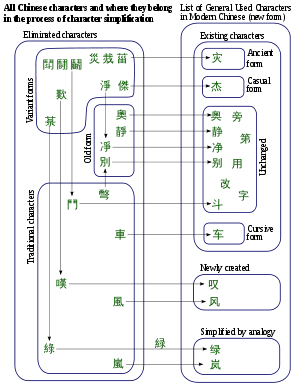- Traditional Chinese characters
-
Traditional Chinese Type Logographic Languages Chinese Time period Since 5th century AD Parent systems Oracle Bone Script- Seal Script
- Clerical Script
- Traditional Chinese
- Clerical Script
Child systems Simplified Chinese
Kanji
Hanja
Chữ Nôm
Zhuyin
Khitan scriptISO 15924 Hant, 502 Note: This page may contain IPA phonetic symbols. Traditional Chinese characters (traditional Chinese: 繁體中文; simplified Chinese: 繁体中文) refers to Chinese characters in any character set which does not contain newly created characters or character substitutions performed after 1946. It most commonly refers to characters in the standardized character sets of Taiwan, of Hong Kong, or in the Kangxi Dictionary. The modern shapes of traditional Chinese characters first appeared with the emergence of the clerical script during the Han Dynasty, and have been more or less stable since the 5th century (during the Southern and Northern Dynasties.) The retronym "traditional Chinese" is used to contrast traditional characters with Simplified Chinese characters, a standardized character set introduced by the government of the People's Republic of China on Mainland China in the 1950s.
Traditional Chinese characters are currently used in Taiwan (Republic of China), Hong Kong and Macau. They were also used in mainland China before the People's Republic of China simplified them in the 1950s and 1960s. In overseas Chinese communities other than Singapore and Malaysia, traditional characters were most commonly used,[1] although the number of printed materials in simplified characters is growing in Australia, USA and Canada, targeting or created by new arrivals from mainland China. A large number of overseas Chinese online newspapers allow users to switch between both sets. In contrast, simplified Chinese characters are used in mainland China, Singapore and Malaysia in official publications. The debate on traditional and simplified Chinese characters has been a long-running issue among Chinese communities.
 Symbol of Traditional Chinese Character in Computers
Symbol of Traditional Chinese Character in Computers
 An Euler diagram showing where Traditional Chinese characters fit in the process of character simplification.
An Euler diagram showing where Traditional Chinese characters fit in the process of character simplification.
Contents
Chinese names
Traditional Chinese characters (Standard characters) are referred to by several different names within the Chinese-speaking world. The government of Taiwan officially calls traditional Chinese characters standard characters or orthodox characters (traditional Chinese: 正體字; simplified Chinese: 正体字; pinyin: zhèngtǐzì; Zhuyin Fuhao: ㄓㄥˋ ㄊㄧˇ ㄗˋ). However, the same term is used outside Taiwan to distinguish standard, simplified and traditional characters from variant and idiomatic characters.[2]
In contrast, users of traditional characters outside Taiwan, such as those in Hong Kong, Macau and overseas Chinese communities, and also users of simplified Chinese characters, call them complex characters (traditional Chinese: 繁體字; simplified Chinese: 繁体字; pinyin: fántǐzì; Zhuyin Fuhao: ㄈㄢˊ ㄊㄧˇ ㄗˋ). An informal name sometimes used by users of simplified characters is "old characters" (Chinese: 老字; pinyin: lǎozì; Zhuyin Fuhao: ㄌㄠˇ ㄗˋ).
Users of traditional characters also sometimes refer them as "Full Chinese characters" (traditional Chinese: 全體字; simplified Chinese: 全体字; pinyin: quántǐ zì; Zhuyin Fuhao: ㄑㄩㄢˊ ㄊㄧˇ ㄗˋ) to distinguish them from simplified Chinese characters.
Some traditional characters users argue that traditional characters are the original form of the Chinese characters and cannot be called "complex". Similarly, simplified characters cannot be "standard" because they are not used in all Chinese-speaking regions. Conversely, supporters of simplified Chinese characters object to the description of traditional characters as "standard," since they view the new simplified characters as the contemporary standard used by the vast majority of Chinese speakers. They also point out that traditional characters are not truly traditional as many Chinese characters have been made more elaborate over time.[3]
Some people refer to traditional characters as simply "proper characters" (Chinese: 正字; pinyin: zhèngzì) and modernized characters as "simplified-stroke characters" (simplified Chinese: 简笔字; traditional Chinese: 簡筆字; pinyin: jiǎnbǐzì) or "reduced-stroke characters" (simplified Chinese: 减笔字; traditional Chinese: 減筆字; pinyin: jiǎnbǐzì) (simplified- and reduced- are actually homonyms in Mandarin Chinese, both pronounced jiǎn).
The use of such words as "complex", "standard" and "proper" in the context of such a visceral subject as written language arouses strong emotional reactions, especially since there are also political ramifications in this case. Debate on traditional and simplified Chinese characters explores the differences of opinion that exist on this matter within Chinese-speaking regions.
Printed text
When printing text, people in China, Malaysia and Singapore mainly use the simplified system, developed by the People's Republic of China government in the 1950s. However, the PRC also prints material intended to be read outside of mainland China using traditional characters, and the reverse is also true. In writing, most people use informal, sometimes personal simplifications. In most cases, an alternative character (異體字) will be used in place of one with more strokes, such as 体 for 體. In the old days, there were two main uses of alternative characters. First, alternative characters were used to avoid using the characters of the formal name of an important person in less formal contexts as a way of showing respect to the said person by preserving the characters of the person's name. This act is called "offense-avoidance" (避諱) in Chinese. Secondly, alternative characters were used when the same characters were repeated in context to show that the repetition was intentional rather than an editorial mistake (筆誤).
Computer encoding
In the past, Traditional Chinese was most often rendered using the Big5 character encoding scheme, a scheme that favors Traditional Chinese. Unicode, however, has become increasingly popular as a rendering method. Unicode gives equal weight to both simplified and traditional Chinese characters. There are various IMEs (Input Method Editors) available to input Chinese characters. There are still many Unicode characters that cannot be written using most IMEs; one example would be the character used in the Shanghainese dialect instead of 嗎, which is U+20C8E
Wikimedia Foundation. 2010.
- Seal Script
Chinese characters — Unless otherwise specified Chinese text in this article is written in the format (Simplified Chinese / Traditional Chinese; Pinyin). In cases where the Simplified and Traditional Chinese characters are identical, the Chinese term is written only… … Wikipedia
Traditional Chinese — noun Chinese written using traditional Chinese characters, used in the Republic of China (Taiwan), Hong Kong, Macau, Korea and also in mainland China and Japan prior to script simplification and today for certain purposes, Fantizi Syn: Fantizi … Wiktionary
Simplified Chinese characters — Simplified Chinese Type Logographic Languages Chinese Time period Since 1956 Parent systems … Wikipedia
traditional Chinese — form of Chinese characters used mostly in Taiwan and Hong Kong … English contemporary dictionary
Debate on traditional and simplified Chinese characters — Debate about the simplification of Chinese characters Traditional Chinese 漢字簡化爭論 Simplified Chinese … Wikipedia
Chinese input methods for computers — Chinese characters Scripts Precursors · Oracle bone script · Bronze script · Seal script (large, small) · Clerical script · Cu … Wikipedia
Chinese pronouns — (known as 代词 dàicí) differ somewhat from their English counterparts. For instance, there is no differentiation between he , she and it , though a written difference was introduced after contact with the West, and with the exception of the… … Wikipedia
Chinese surname — Chinese family names have been historically used by Han Chinese and Sinicized Chinese ethnic groups in mainland China, Taiwan, Hong Kong, and among overseas Chinese communities. In ancient times two types of surnames, family names (Chinese: 姓;… … Wikipedia
Chinese Soviet Republic — 中華蘇維埃共和國 Unrecognized state ← … Wikipedia
Chinese Wikipedia — 中文維基百科 中文维基百科 … Wikipedia

